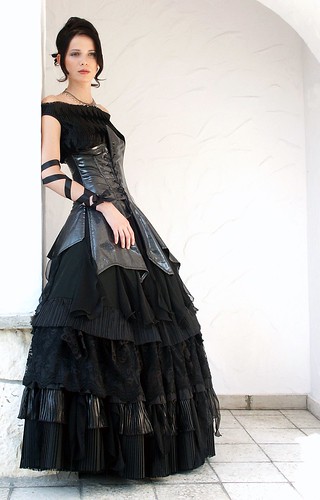
Medley News: Spooky Dress is an unambiguous black or dim elegance of sartorial worn out by the followers of the Goth subgroup. Gothic fashion sartorial, which is deliberated by numerous as a dissent in contradiction of the luxury, can be defined as an excess of dark velvets, fishnets, lace, tight corsets, gloves and leather shaded with scarlet. Gothic clothing also types Gloomy make up such as black lips, dark eyeliner, dark finger-nails and black colored hair. The Gothic time clothing is frequently separated into two periods, Early Gothic period (1200-1350) and Late Gothic period (1350-1450). The clothes in the Early Gothic period were extra classy, elegant and humbler in expurgated than the Romanesque period. Covers used to be close-fitting and the forewarns were given more prominence. Negligible appurtenances on the Gothic clothing were also a piece of the Early Gothic period. The Gothic clothes were typically lengthier and the necks were deep. Panaches altered rapidly throughout the Late Gothic period. The retro enthused from the previous graceful drapes that changed, into materials that retained on becoming additional and firmer with the passageway of time. During the 15th century, the excesses were typically in the higher outline. Crunchy pleats, fitted belts, lengthened doublets, leg-o-mutton sleeves were similarly several of the significant types of the Gothic sartorial in the Late Gothic period. In the Early Gothic period, menfolk wore hair at a levelheaded length frequently in a bow to the jaw line with a boom crossways the brow. Men frequently faded their hair as blond hair was general. Rare men wore whiskers. In the Late Gothic period, menfolk wore hair bobbled with gracefully curly finishes. Young girls in both periods wore their hair unfastened, rolling upon their shoulders. But after nuptial, they used to restrain their hair in a roll at the nape. They also used to wear numerous kinds of hair pieces, such as wimple and gorget, to cover it. Gothic corset is a significant piece of Gothic clothing. It forms the body of a girl like an hourglass. It was very prevalent throughout the Victorian and medieval eons. Even nowadays, Gothic corset is commonly prevalent as even today, hourglass form of a girl’s is reflected as artistic and gratifying. At the inception, a Gothic corset was very rough to attire. It is merely with the passageway of time that the clothing converted more lenient and suitable to attire. Gothic garments like nettings are summer temperature responsive. Fishnets can be worn out on arms, legs or even as tops and jumpers. Cotton bloomers, lace-trimmed long skirt and graceful delicate skirts are specific of those parts of Gothic sartorial that are very comfortable to attire in the summertime. Men wear shirts with perturbs, buckles and lacing that appearance just like buccaneer shirts. In summertime, male Goths attire light natural grit shirts and short black trousers, ornamented with wide-brimmed hats, black umbrellas and silver knick-knacks. Gothic sartorial is imperfect lacking Gothic gumboots. Woman Goths typically attire dark black boots with high heels, while Gothic men attire dark black flatted boots, which are commonly weighty. Though, one can too originate crosswise Goths tiring bloody-red boots. Source: Medley News, Image: flickr.com
